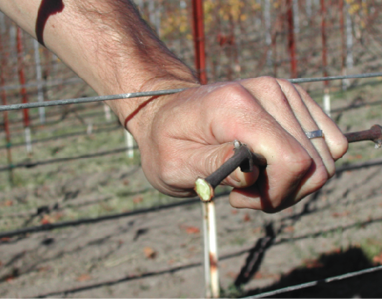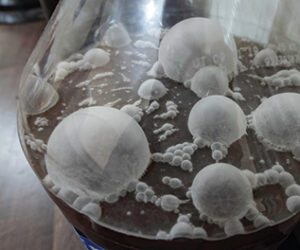
Once a year I answer questions from the WineMaker magazine readers. It’s one of my favorite articles, because I always learn something from both my research and the great questions submitted by our subscribers. Having this magazine in your hands allows you to reach out to me at any time with questions about growing grapes, winemaking or anything else you’d like to rap about. If you are sending me questions about a vineyard or a few vines, make sure to include as many pictures as possible with your email. It’s very hard to diagnose a problem from a description, much like it’s hard to fix a car when someone says, “It makes a click, click then a ‘gazonka gazonka’ noise.”
2014 has been a crazy year all over the country. The Midwest and East Coast had a brutally cold winter that tested the vines’ hardiness and caused permanent bud and wood injury for many vines in the coldest climates. We had the opposite problem in California. We had no winter. High 70s and 80s persisted through much of January and February and we felt lucky that budbreak waited until early March at Clos Pepe (Sta. Rita Hills, Santa Barbara County). A friend who grows Pinot Noir only five miles towards the coast had budbreak in mid-February, which is unheard of in these parts! To our benefit, we had no frost and the canopy development was uncharacteristically fast. We had full canopy in early May.
Before I get to the questions, let me start with a few suggestions for vines in various parts of the country: Drought/heat stricken West: Be judicious but generous with irrigation in putting your vines to sleep. If you have been using sprinklers in your vineyard for irrigation, allow me to suggest that the drought is too severe to be using such an inefficient method of watering, and it would be great for all of us here in the West for you to consider drip irrigation, even if it’s just a hose with holes poked in it. If the vines carried a heavy crop the past few years, consider some supplemental fertilization a few weeks after budbreak in 2015. A handful (cup) of 15-15-15 fertilizer with micronutrients should do the job. Skip this if your vines are overly vigorous year after year. And if we don’t get the El Niño, make sure to give your vines a good drink of water before those buds open up, and preferably at least a few weeks before budswell.
Areas in the Northeast and Midwest/ Northern Tier that had cold damage: This is a complicated issue that could take up an entire issue. Go to your computer and Google: “Cornell grapevine cold injury” and you will pull up half a dozen excellent articles on assessing and helping injured vines recover.
On to the questions!
JT Matherly in Rancho Cucamonga, California writes: Hi, Wes! We’ve had a brutally fast and hot season down here near Los Angeles. My 300 Zinfandel vines are harvested and losing leaves already (mid-September), and I’m wondering if I can get a jump on pruning this year. How do I know when the vine is fully dormant so I can start pruning?
Wes answers: I don’t suggest pruning quite yet. The vine is going through a very important process of shutting down and “going to sleep,” which we call dormancy. It may look like the vine is going to sleep, but after harvest is a very busy time for a vine. After it is “relieved” of its crop, a vine does a few things. First it has a “root flush,” which is a process of strong root growth. Second, the vine will take excess nitrogen not used in the vintage, convert it to arginine and store it in the trunk and taproot. Premature pruning will impact both of these processes, so you really need to wait until full dormancy to prune.
So that begs the question: When should I prune? My answer is this: The more frost-prone your region, the later you should prune. I like to prune at budswell in my lowest, most frost-prone sections of my vineyard, usually in late February or early March. That way the vine has to heal the pruning wounds and re-pressurize the wood with Xylem fluid, pushing off budbreak a good 10–14 days if timed right.
With no frost pressure, how early can I prune? My normal answer is: Make a test cut on a few dormant canes, at least two months after harvest and at least a month after the last leaf has fallen off. Do this on a warm winter day to be sure. If the cuts on the vine side do not “bleed” clear fluid (Xylem) after a few hours, the vine is solidly in dormancy and can be pruned. In the Northern Hemisphere I wouldn’t prune before December, generally.
I hope this helps your pruning schedule. Remember: Pruning is the foundation for the entire vintage, and I believe it is the most important cultural practice to time correctly and finish with proper protocol.
Darci Whitaker in Monticello, Virginia writes: We had a tough time with Japanese beetles this year, and even though I thought the situation was under control, our fermented wine from the last few years has an odd aroma that some local pros tells me is a residual smell from these insect pests. Is there an easy way to spray or use some cover crop to get rid of them?
Wes answers: Japanese beetles? Oh, you won’t like my answer. Without hard pesticides (unavailable to home growers), Japanese beetles are almost impossible to exclude from the vineyard. The good news is they don’t generally eat grapes, the bad news is that they will skeletonize your grape leaves (normally between 5-10% of leaf area can be eaten in a vineyard, which isn’t too bad), but even a few beetles in your fermentations will ruin the flavor of your wine. And, unfortunately, there is no fix to remove the unpleasant aromas (methoxypyrazines) in your wine from the beetles. One way to mask those aromas is to use oak chips. You worked too hard to grow good wine to have it taste of stink-bug!
So how can you control them? Here are some tips:
1. A bare vineyard floor will reduce egg laying.
2. Remove plants that attract the beetles and add plants that don’t lure them. There’s a great list in an article I used from the Department of Entomology at Michigan State University for research: Google “MSU Japanese Beetle Grapevine” and it will be on top.
3. You will notice considerably reduced amounts of Japanese beetles in drought conditions, as the larvae are very susceptible to minimal water supply.
4. Most effective sprays require a permit, but there’s a good list of organic alternatives at the same MSU site.
5. You can put traps out to monitor populations in the vineyard, but in my opinion there is no lure trap that is all that effective.
6. When I did my Grape Growing Boot Camp at the WineMaker Magazine Conferences in Ithaca, New York and Virginia, the awful truth was made clear to me: The best way to control Japanese beetles is to remove them by hand from the vineyard before harvest.
7. Another suggestion is to carefully sort them out of harvested grapes on a sorting table during crush, but this can be very difficult, especially in white varieties.
8. There has been some success with certain wasp species that eat the larvae, but if there’s Japanese beetles in your vineyard, they will come back every year no matter what you try.
9. My best (albeit a bit lame) suggestion is to have a Japanese beetle picking party where a dozen folks go through your vineyard and try to remove all the beetles before harvest. If you pull this off you have really, really good friends. Reward them with good booze before, during and after. Then have them wash their hands.
James Singleton in the Augusta region, Missouri writes: Controversy continues to swirl around Missouri wine country and I would like your advice. Many of my winemaking friends, both pro and amateur, tell me that we can successfully grow vinifera (European) varietals in Missouri, and some say we should stick to the hybrids like Norton, Chambourcin and Seyval Blanc. What is your opinion?
Wes answers: I honestly wish more wine critics and wine lovers would stop beating up on Euro-American hybrids, because I believe they make great wine! While I have never had a vinifera wine worth drinking from Missouri (my experience is limited), I have had Norton from Stone Hill and Victor Hugo that have been balanced, deeply colored, rich, and delicious. I even put a bottle of Stone Hill in a blind Northern California Cabernet tasting, and the “wine geeks” were flabbergasted that it rated in the top half of the wines by adding the scores of the tasters. So I have a very strong opinion about this, and that opinion is that hybrids are better suited for Missouri than vinifera. It’s a tough call, though! If intrepid vineyardists are having success with Eurasian winegrapes in your region, why should we stop them? With a few decades of experience, why couldn’t Missouri have the same type of success that’s emerging from the Northeast with grapes like Merlot, Cabernet Franc and Viognier?
Here’s my final word: If you want to sleep soundly at night, minimize spraying, bring in a sound crop every year and make good wine in the next 10 years, go with Norton or Chambourcin. If your hair is on fire with the desire to change the world and prove all of us West Coast vinifera-snobs wrong, go ahead and plant some vinifera. Close to your home: Amigoni winery is committed to vinifera and likes Petit Verdot. So go visit them (www.winery.amigoni.com), bring them some nice bottles and ask them if they would do it again, and if they would, what would they do differently.
Russell Dodlinger in Paso Robles, California asks: We are in a serious drought in California, and even though they are talking about an El Niño to give us some much-needed rain, we have to prepare for the worst: Another dry winter. For the small production/home wine grower, are there some water-saving strategies for the vineyard and winery you can suggest?
Wes answers: Grapevines have been known to survive in very arid regions for decades, so they are very efficient at using limited water supplies. There’s certainly some best practices that should be discussed as we go forward in this drought, many of which I’ve put into use here on our family’s vineyard near Lompoc, California. Here are some strategies for reducing water use in drought-stricken areas:
• Reduce irrigation frequency, but increase amount of water applied. Many growers in California have reduced their water use by up to 50% using this method. So if you apply 5 gallons (19 L) per plant per week, apply 20 gallons (76 L) once every six weeks. This method only works in soils with high clay content (water-holding capacity). In sandy soils this type of irrigation will move too rapidly through the soil profile to add any conservation, and will likely cause the vines to shut down prematurely.
• Use and/or replant with drought-tolerant rootstock. 110R, 1103P, 420A, Freedom and Harmony have proven themselves as being sippers and show positive results in drought conditions. Make sure these rootstocks are compatible with your climate and soil.
• Ditch the sprinklers. Sprinklers are so 20th century. All the cool kids are using drop irrigation these days, and delivering twice the water applied to the root zone, three times more than sprinkling on a hot, dry day. Sprinklers also soak the fruit and cause more mildew and rot to spread and grow. Drip irrigation may be more expensive to install, but using sprinklers for irrigation during a drought is just plain irresponsible.
• Don’t irrigate during the growing season until the tendrils at the shoot tips pull back even with the emerging leaves/shoot tip. This is a signal of water stress early in the year. As long as the tendrils are reaching out as the vine grows, the vine recognizes it has enough water and requires little to no irrigation. In cases of zero water in the soil profile in spring (severe drought), this may not work and you may need to moisten the soil in advance of the vines waking up.
• Let the vines stress a bit more. Reduce your irrigation 10% a year during a drought and you may be surprised how little impact it has on the vine and fruit quality. Keep reducing your irrigation until the vines show visible stress: Drooping leaves and a tired appearance. Give them a drink to perk them back up before they start shutting down.
Conservation of water is critical in California this year, and until we get a good soaking (15+ inches/38+ cm of winter rains), it will be extremely important to save the precious little water we have. Give these strategies a try, and let me know how they work out for your vineyard!
Thanks again to all of you who submitted questions. If you would like to ask a question for a future column, or to get answers via email, check in with me at [email protected].







